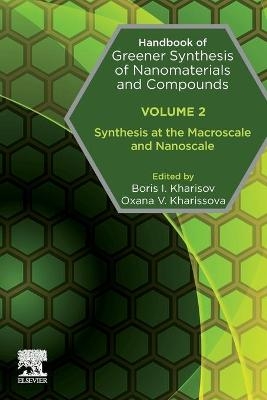
Handbook of Greener Synthesis of Nanomaterials and Compounds
Elsevier Science Publishing Co Inc (Verlag)
978-0-12-822446-5 (ISBN)
Volume 2: Synthesis at the Macroscale and Nanoscale explores synthesis at different scales. Beginning with a selection of chapters discussing a range of macroscale topics, the book goes on to explore such important areas as metal nanoparticle synthesis, biogenic synthesis, and synthesis of enzymes. Further chapters explore the role of Metal Organic Frameworks in greener synthesis, synthesis from renewable sources, and impacts of nanomaterials synthesized by greener methods.
Dr. Boris Kharisov is currently a Professor and Researcher at the Universidad Autónoma de Nuevo León (UANL). He took part in the liquidation of the consequences of the Chernobyl accident, working in the contaminated zone in 1987. He received his M.Sc. in 1986, in radiochemistry and a PhD in inorganic chemistry in 1993, from the Moscow State University, Russia; Dr. Hab. in physical chemistry in 2006 from Rostov State University, Russia. Dr. Kharisov’s specialities are materials chemistry, coordination and inorganic chemistry, phthalocyanines, ultrasound, nanotechnology, chemical treatment of petroleum, environmental remediation. He is a member of the Mexican Academy of Science and National Researchers System (SNI, Level III), is the co-author of 13 books, 171 articles, 13 book chapters, and holds eight patents. In addition, he has co-edited three invited special issues of international journals, and is the member of the Editorial board of six journals. His biography was published in: “Who is Who in the World and “Outstanding People of the Twentieth Century. Dr. Oxana Kharissova is currently a Professor and Researcher at the Universidad Autónoma de Nuevo León (UANL). She received her M.Sc. in 1994, in crystallography from Moscow State University, Russia, and a Ph.D. in Materials from the Universidad Autónoma de Nuevo León, Mexico. She is a member of the National Researchers System (SNI, Level II), Materials Research Society and Mexican Academy of Science. She is the co-author of 8 books, 13 book chapters, 87 articles, and holds 9 patents. Her specialties are materials, nanotechnology (carbon nanotubes, graphene, nanostructurized metals, fullerenes), microwave irradiation and crystallography; nanotechnology-based methods for petroleum treatment. Dr. Kharissova holds the awards “Flama, Vida y Mujer 2017 and “Tecnos (2004). She is an expert of the National Council for Science & Technology of Mexico (Conacyt).
Part 1: Greener Synthesis: Synthesis at Macroscale
1. Polyhydroxyalkanoates: naturally occurring microbial polymers suitable for nanotechnology applications
2. Green protocols for active pharmaceutical ingredients (API)
3. Development of CO2-based polyols and their use in nanomaterials
4. Synthesis of Various Heterocyclic Compounds by Environmentally Friendly Green Chemistry Technologies
5. Greener synthesis of enzymes from marine microbes using nanomaterials
Part 2: Greener Synthesis: Synthesis at Nanoscale
6. Green synthesis of iron oxide nanoparticles using plant extracts and their biological applications
7. Green synthesis of selenium nanoparticles: characterization and application
8. Biosynthesis of Silver Sulfide Nanoparticles and its Applications
9. Plant Based Green Synthesis and Applications of Cuprous Oxide Nanoparticles
10. Phytogenic Synthesis of Manganese Dioxide Nanoparticles using Plant Extracts and Their Biological Application
11. Greener synthesis of carbon dots
12. Greener Synthesis and stabilization of Metals Nanoparticles in Ionic Liquids
13. Green synthesis of carbon nanoparticles, characterization and their biocidal properties
14. Hierarchical Nanoporous Silica-based Materials from Marine Diatoms
15. Greener route of obtaining boron-containing nanocomposites
16. Green synthesis of lanthanides and actinides - based nanomaterials
17. Greener synthesis of nanocomposites and nanohybrids
Part 3: Further Aspects of Greener Synthesis
18. CO2 capture by MOFs in green synthesis
19. Environmental aspects of green nanoparticles synthesis
20. Impacts of nanomaterials, synthesized by greener methods, on aquatic vertebrates
21. Green Nanomaterials: Pioneering approach towards hyperthermia treatment
22. Design of electromagnetic absorbers based on green nanomaterials
23. Energy-efficient routes of fabricating thermoelectric materials
24. Water splitting: Design, synthesis and fabrication of nanostructured materials based efficient electrodes for water splitting applications
25. Recent strategies for improving semiconductor performance for solar water splitting
26. PHOTOCATALYTIC HETEROSTRUCTURED MATERIALS FOR AIR DECONTAMINATION AND SOLAR FUELS PRODUCTION
27. SUSTAINABLE ROUTES AND GREEN SYNTHESIS FOR NANOMATERIALS AND NANOCOMPOSITES PRODUCTION
| Erscheinungsdatum | 16.04.2021 |
|---|---|
| Sprache | englisch |
| Maße | 152 x 229 mm |
| Gewicht | 340 g |
| Themenwelt | Naturwissenschaften ► Chemie ► Physikalische Chemie |
| ISBN-10 | 0-12-822446-0 / 0128224460 |
| ISBN-13 | 978-0-12-822446-5 / 9780128224465 |
| Zustand | Neuware |
| Informationen gemäß Produktsicherheitsverordnung (GPSR) | |
| Haben Sie eine Frage zum Produkt? |
aus dem Bereich


